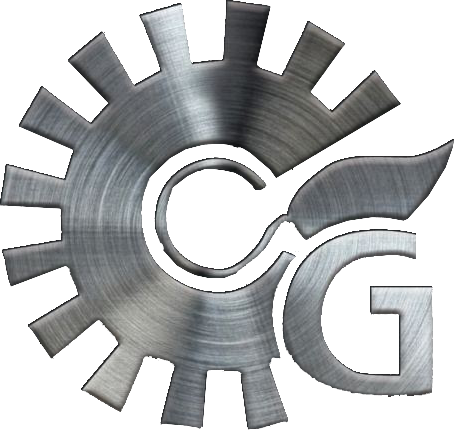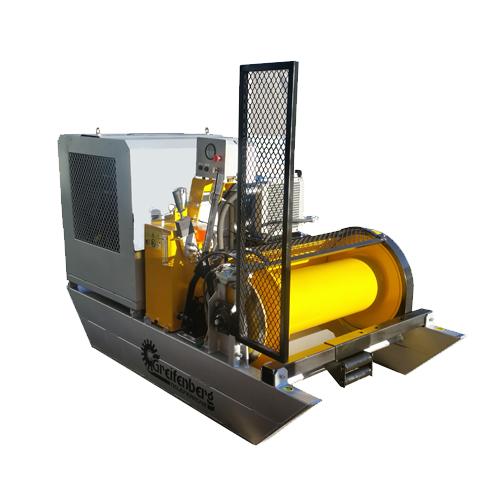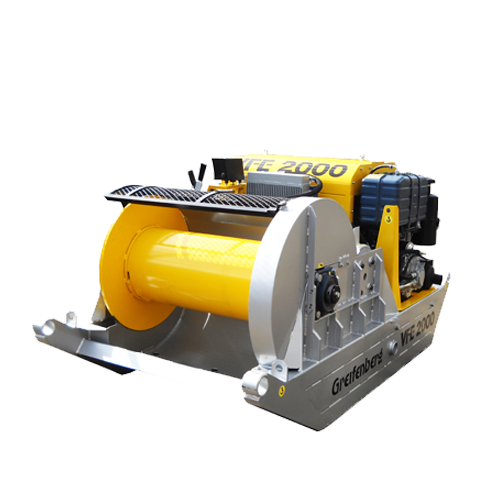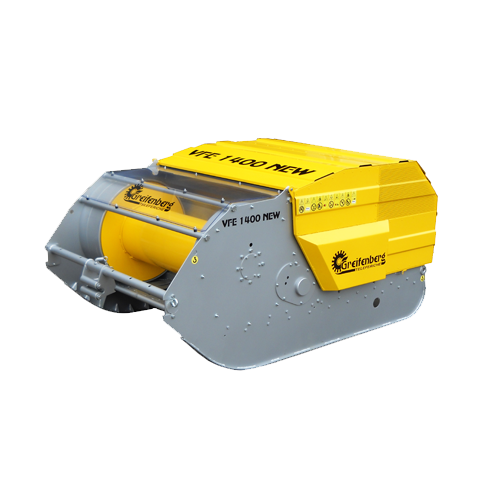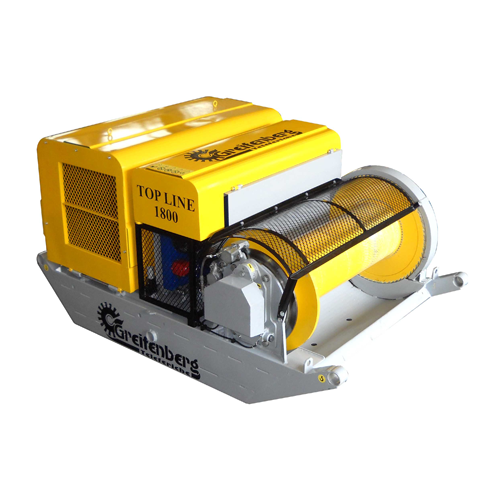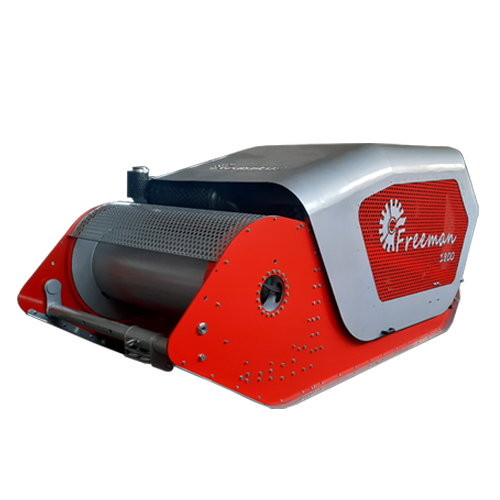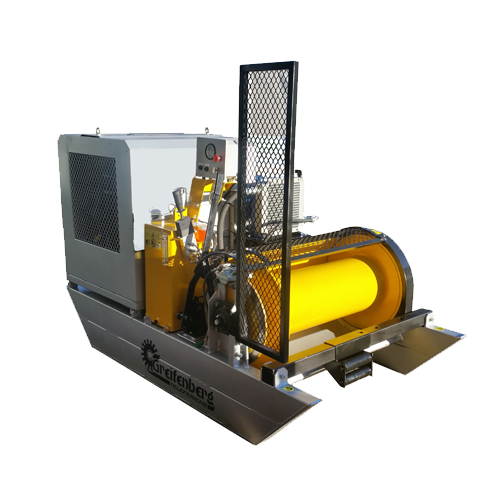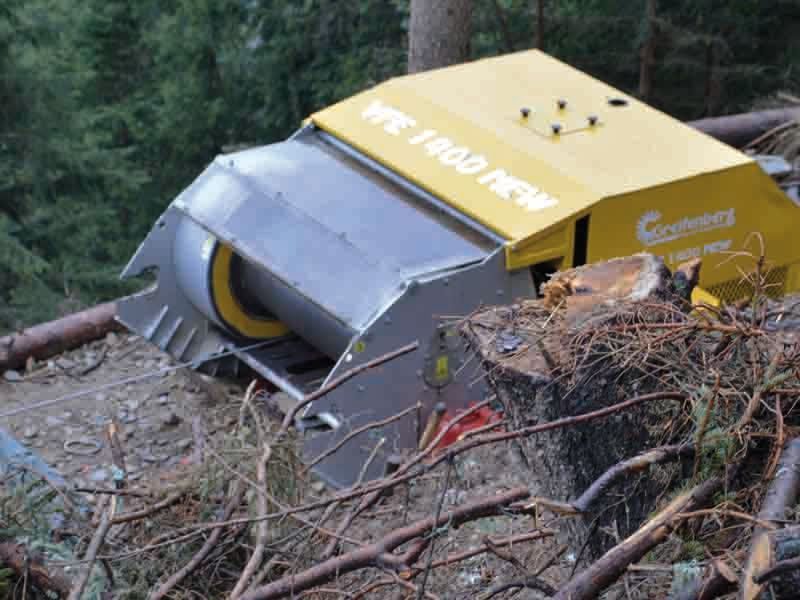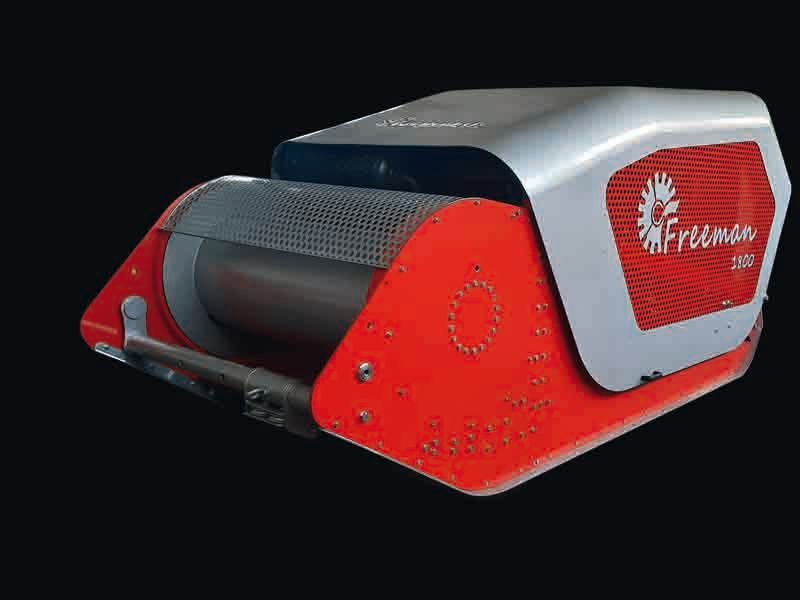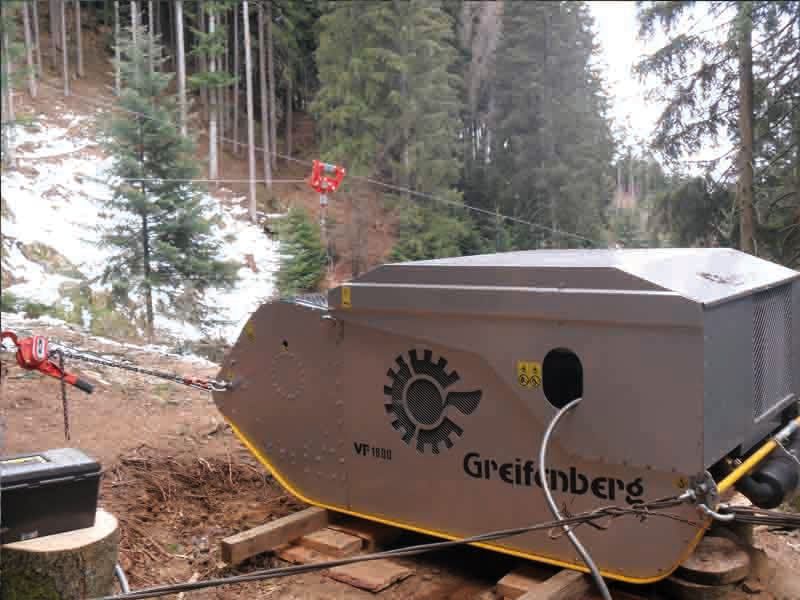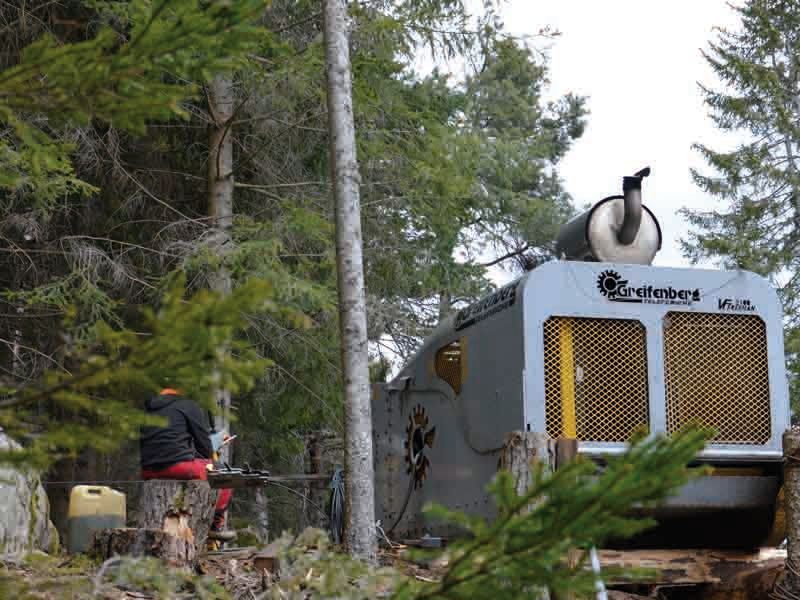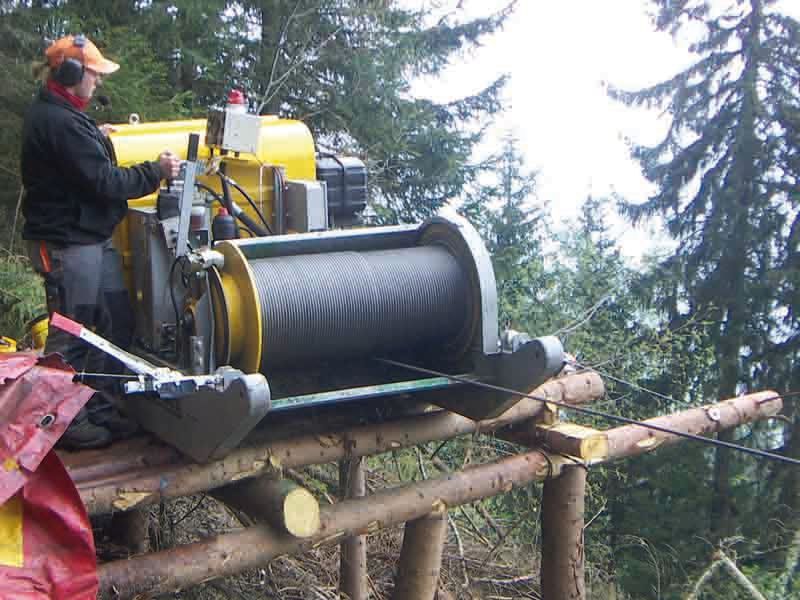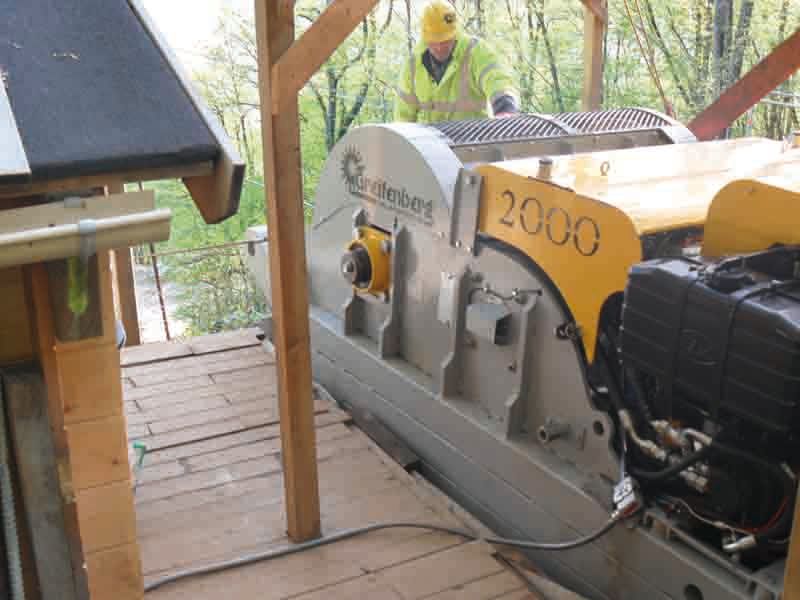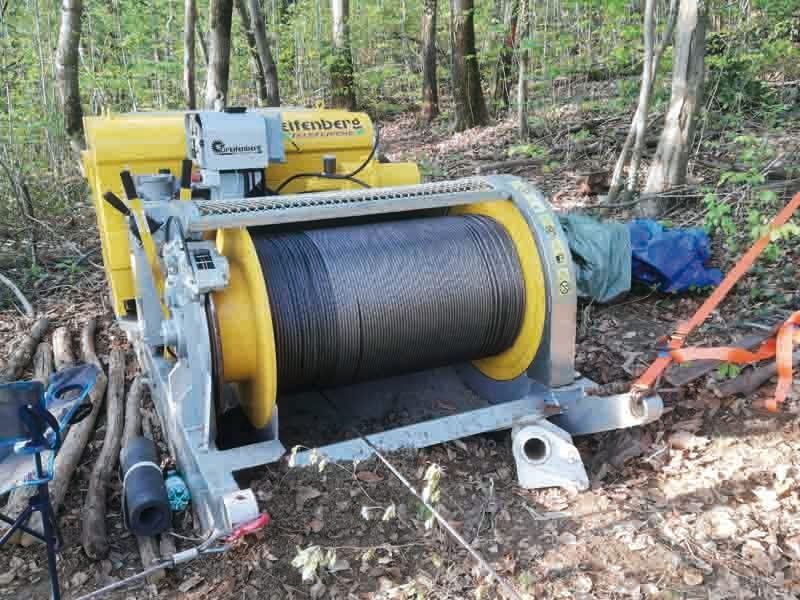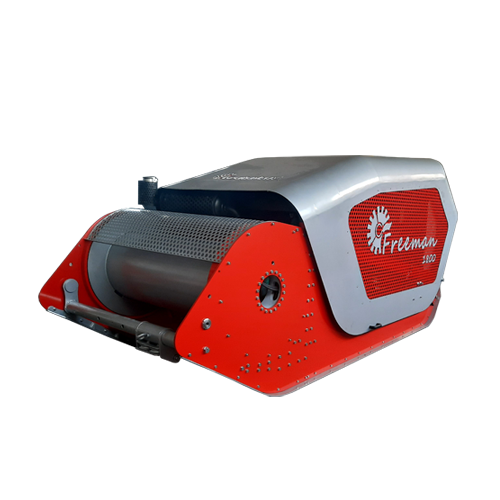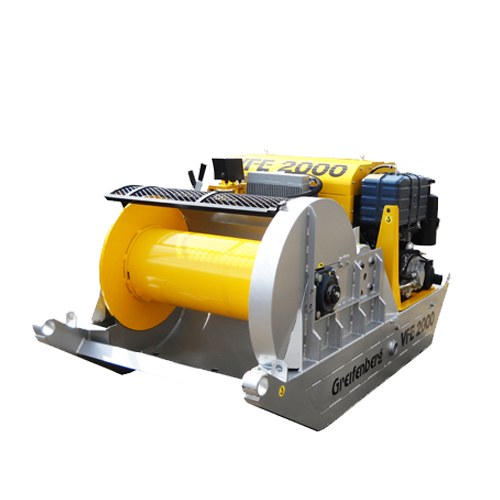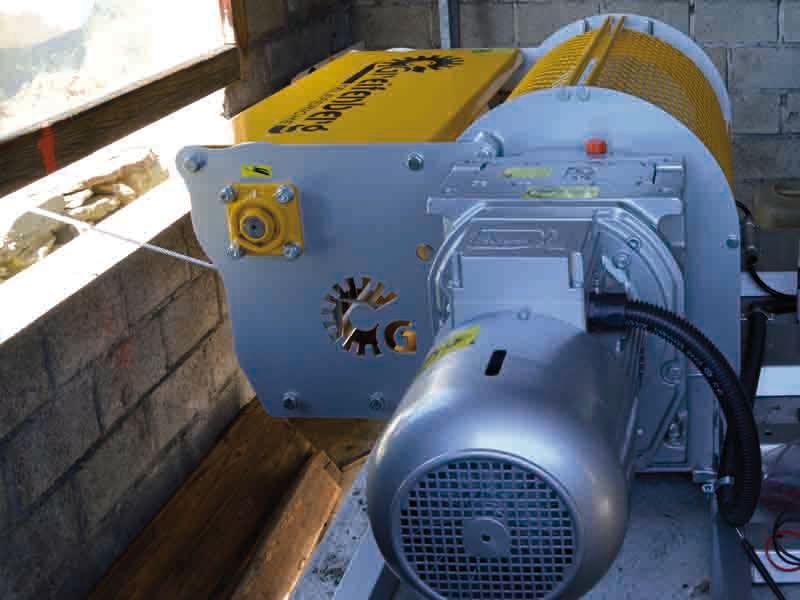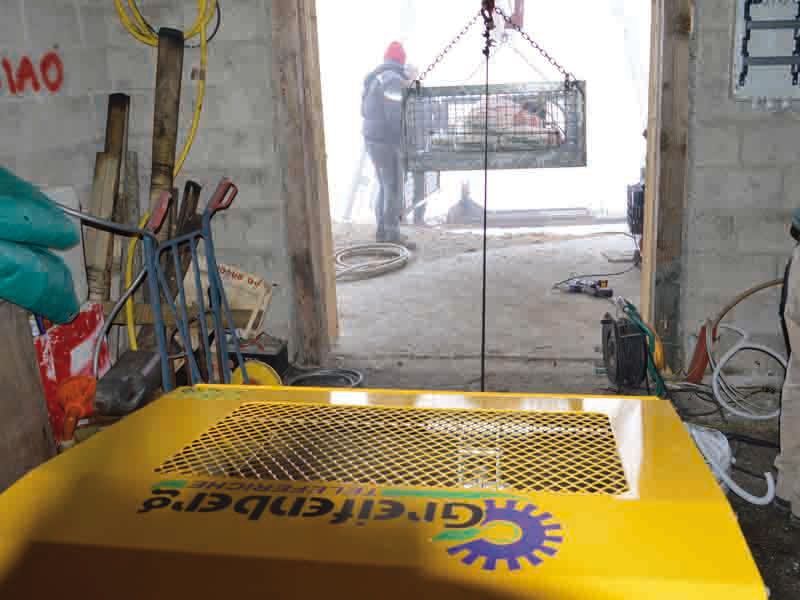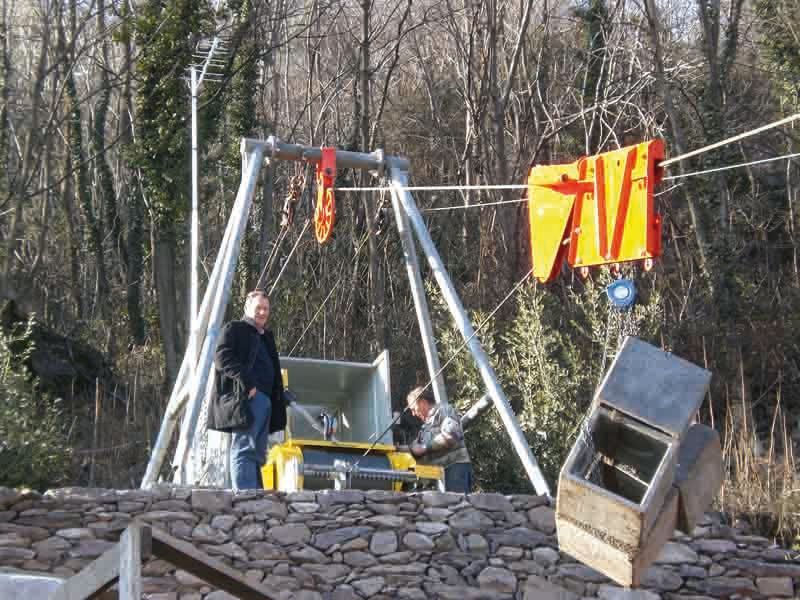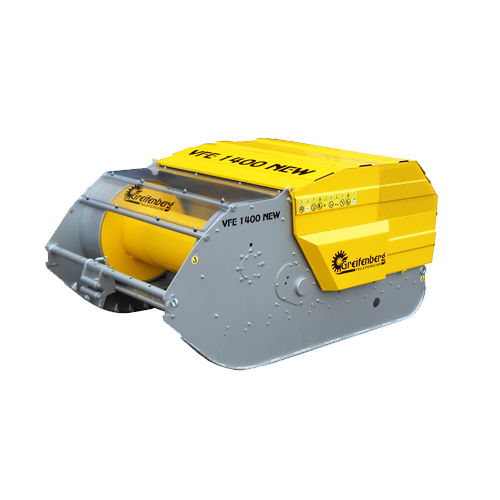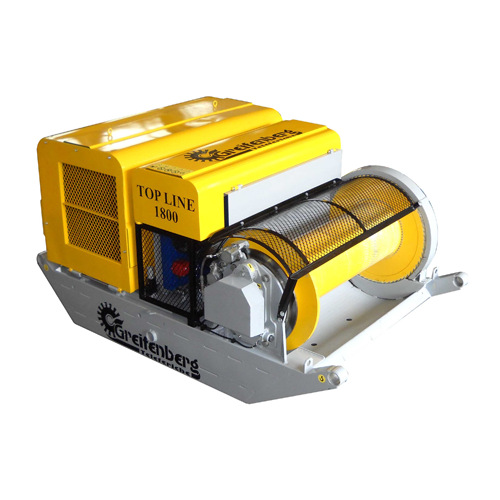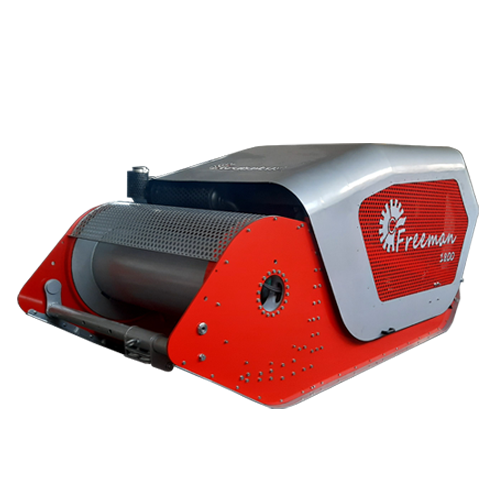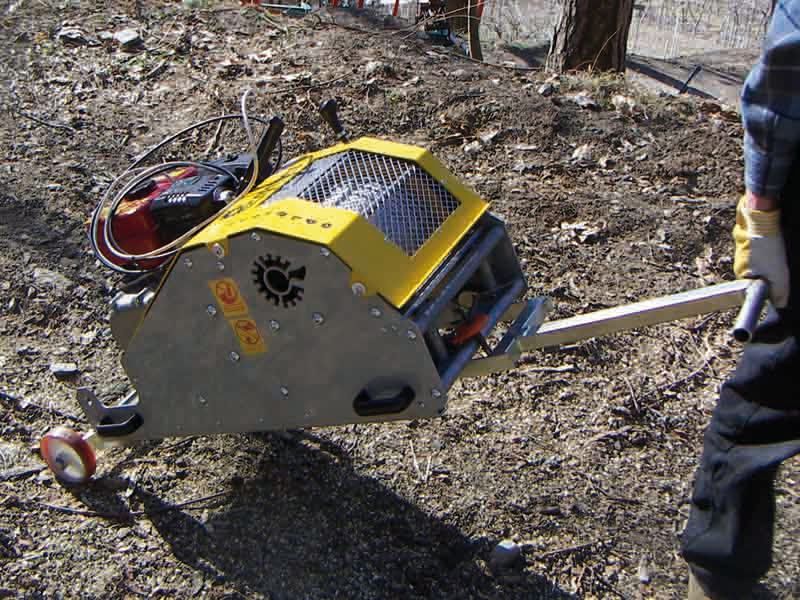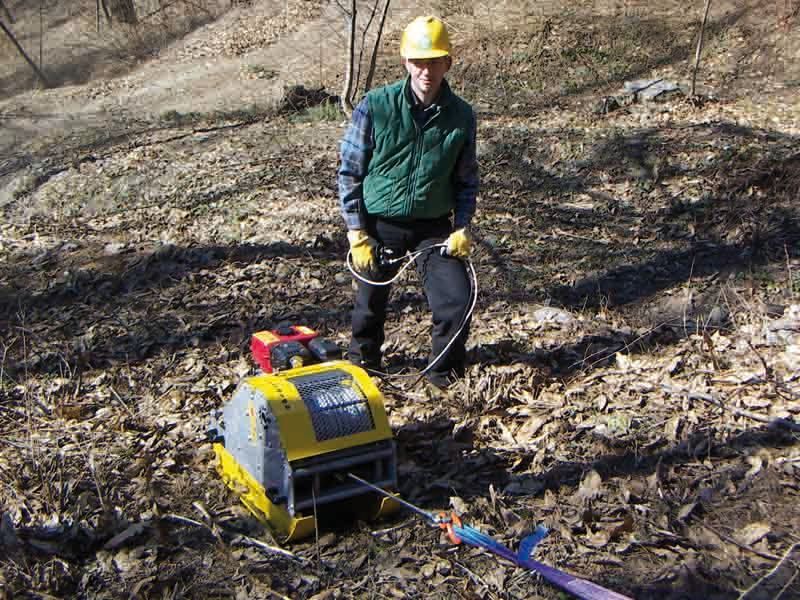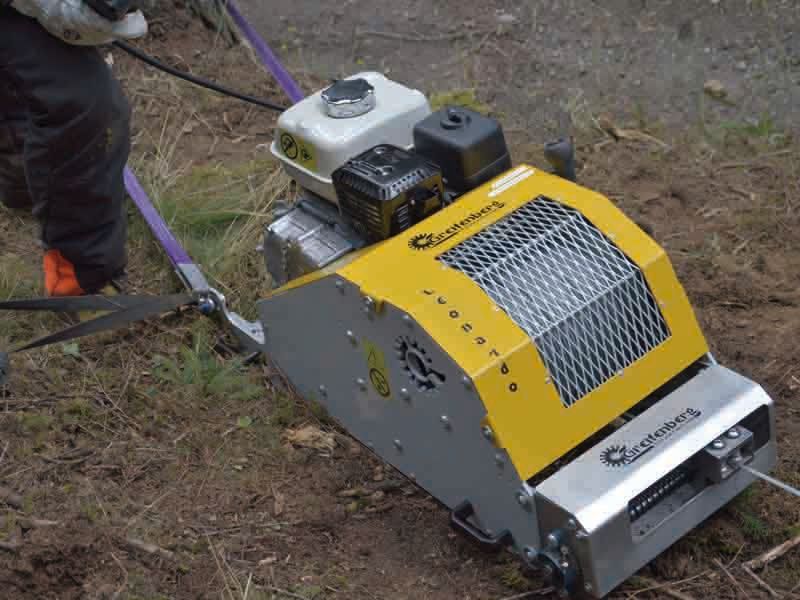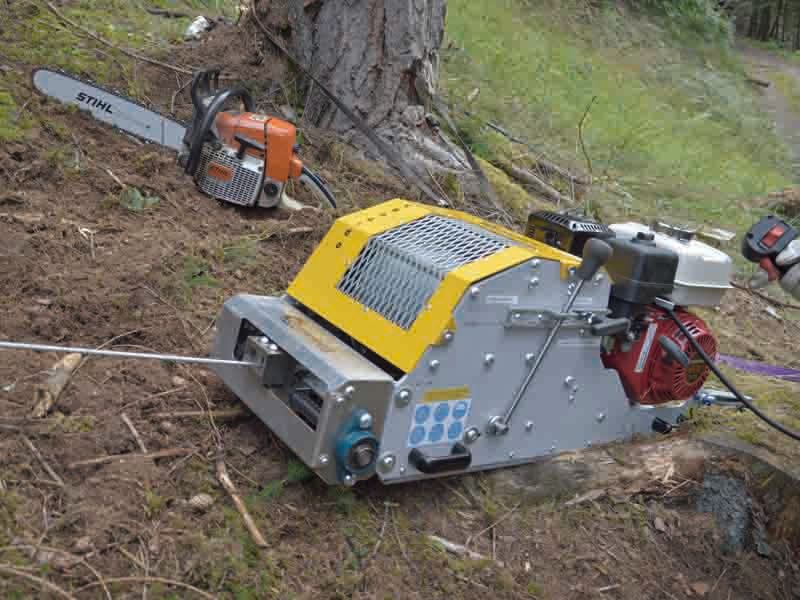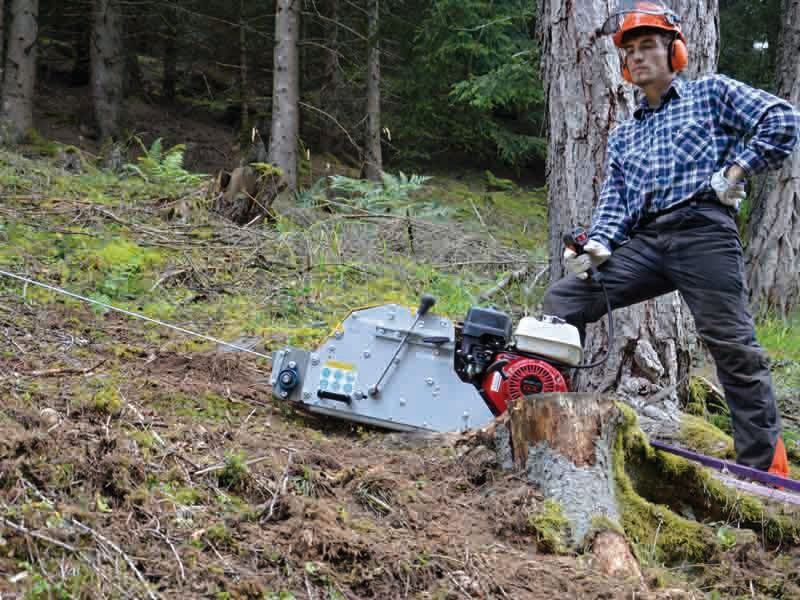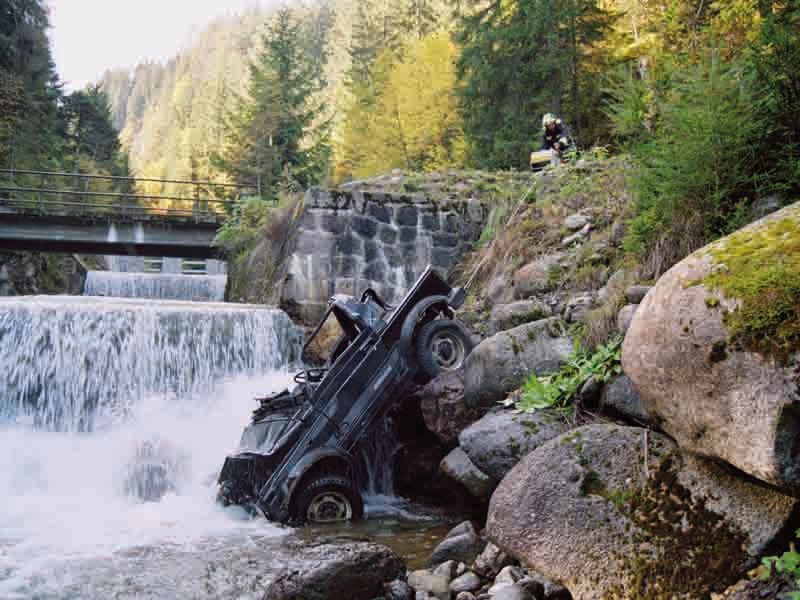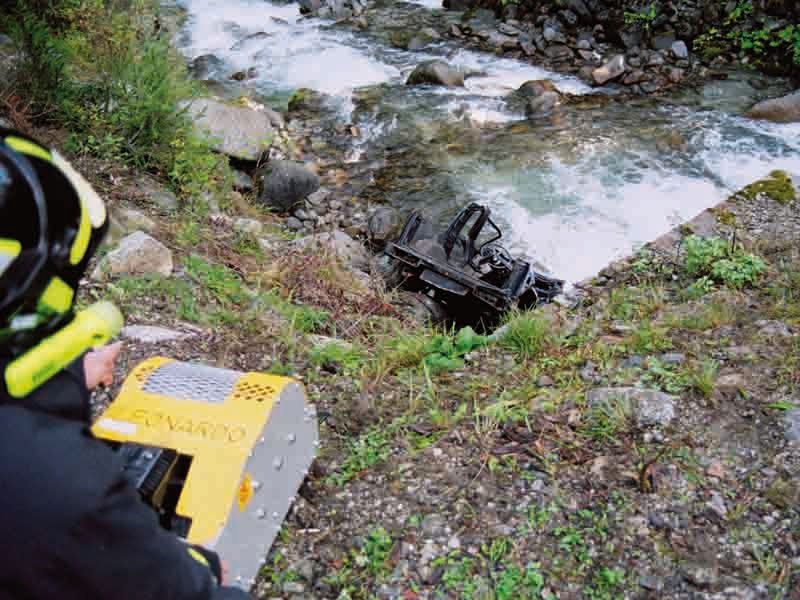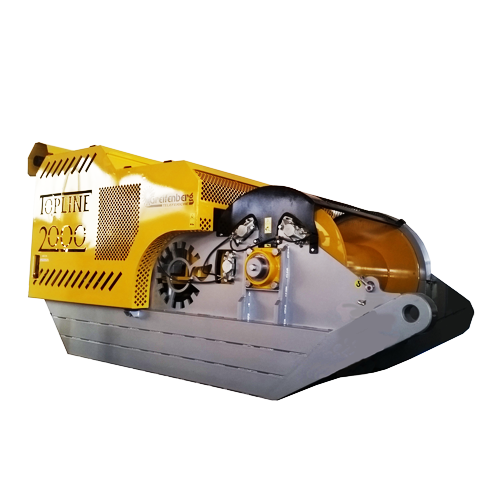Versatile Winches for Every Field of Use
Efficiency and reliability at your service.
Winches for forestry and civil use, with hydraulic retarders, electronic control, hydraulic control, and winch drum systems with ring for valley work. Power ranges from 100 to 300 hp and pulling forces from 4 to 10 tons. For lines from 1200 to 4000 metres.
The VFE 1200 hydraulic winch is easy to use, cost-effective, and ideal for those approaching the forestry sector. It allows the construction of cable car lines both uphill and downhill, up to 1200 metres. The steel skid frame helps the operator during off-road self-dragging, and to improve the drag, the machine can be equipped at the front with a rope guide bar and at the rear with anti-rearward feet that prevent the winch from slipping backwards. Compact and easy to position, it is suitable for both forestry and construction sites. The VFE series features a proportional hydraulic joystick that controls the hydraulic transmission, adjusting the speed of the drum while simultaneously increasing the revolutions of the diesel engine. This allows the operator to manoeuvre the winch with a single control. The hydrostatic closed-loop transmission includes an automatic oil bath brake, with controls located on the machine. Safety during the descent phase is ensured by the manual hydraulic clamp brake, which the operator uses only in the event of malfunctions or breakdowns. The winch can be disassembled into two parts for air transport and is particularly characterised by high performance, long durability, build quality, and CE certification.

A 2300 mm
B 1350 mm
C 1390 mm
| TECHNICAL DATA | |
|---|---|
| Winch type | Steel skid frame |
| Diesel engine power | 45 kw / 62 cv |
| Hydraulic system | Dual Linde pump with a closed circuit |
| Control management | Hydraulics |
| Indicative dry weight | 1,2 ton |
| Dismountable for air transport | 2 parts |
| PULLING DRUM | |
| Rope capacity and diameter | 1100 m d. 11 mm |
| Rope capacity and diameter | 900 m d. 12 mm |
| Tensile strength at the first layer of the rope | 3700 daN |
| Tensile strength at the last layer of the rope | 2200 daN |
| Maximum speed at the last layer of the rope | 4 m/s |
Air transportable
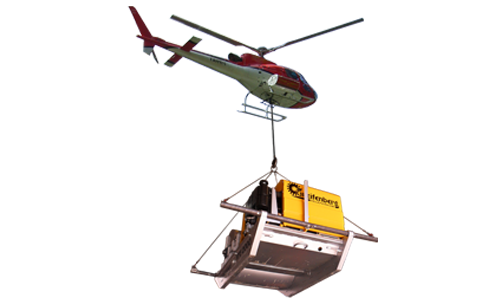
Greifenberg machines and equipment that need to reach work positions without communication routes are designed with modular sections for quick disassembly, allowing the creation of units with a weight of less than 1100 kg. This feature makes it possible to transport them using conventional helicopters. Air transport reduces installation times, and the disassembly/assembly systems of the individual modules are designed to be simple, enabling the team to move the equipment quickly and safely.
The VF Freeman is the top-of-the-range Greifenberg forestry skid winch series. With a unique design to give it an exclusive identity and a striking appearance. The frame is entirely made of Ergal aluminium alloy, with mechanical characteristics 50% superior to normal steel and a 60% reduction in weight. The skids are made of Hardox anti-wear steel, and the hood is removable for convenient checks and routine maintenance. This model allows for the construction of lines up to 2100 metres in length. It is characterised by both high mechanical performance and technological applications. The highest quality of each component: turbo diesel engine, Linde variable displacement pump, axial piston hydraulic motor, additional Load-Sensing hydraulic pump with a retarder function that automatically intervenes at preset thresholds during downhill translation, allowing high speeds without compromising the performance of the diesel engine. The service brake is an automatic oil-bath disc brake, and the hydraulic system uses biodegradable hydraulic oil. The control panel and touchscreen display are easy and intuitive to use, mounted on a mobile support to help position the operator in a safe area. Its modular design facilitates air transport operations, being divisible into three parts, with simple and secure connection and repositioning.

A 3430 mm
B 1760 mm
C 1450 mm
| TECHNICAL DATA | |
|---|---|
| Winch type | Aluminium skid frame |
| Diesel engine power | 115 kw / 156 cv |
| Hydraulic system | Dual Linde pump with a closed circuit |
| Control management | Electronics |
| Indicative dry weight | 2,6 ton |
| Dismountable for air transport | 3 parts |
| PULLING DRUM | |
| Rope capacity and diameter | 2100 m d. 12 mm |
| Rope capacity and diameter | 1750 m d. 14 mm |
| Tensile strength at the first layer of the rope | 7000 daN |
| Tensile strength at the last layer of the rope | 4700 daN |
| Maximum speed at the last layer of the rope | 7 m/s |
| RETARDER | |
| Power | 111 kw - 150 cv |
| Retarder control | Automatic and manual intervention |
Radio System
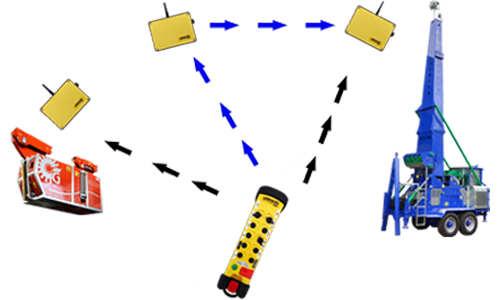
The radio remote controls adopted by Greifenberg are the result of years of field experience concerning operational range and ease of use, comfortably operable with safety gloves. They feature an extremely robust "case" that can withstand drops and heavy impacts. With the convenient shoulder strap, they can be held with one hand, and thanks to the buttons marked with specific icons, manoeuvring during use is extremely simple. A powerful battery ensures a full working day, and the standard supply also includes a spare battery and a charger.
The brain of the radio system is located in the key inserted into the remote control, where communication codes and protocols are stored.
From the remote control, all manoeuvres that are typically done from the machine's touchscreen panel can be carried out. It is possible to start and stop the diesel engine, increase and decrease the rope speed, set and update the end of the line or loading point, make moves outside the set parameters using the dedicated “by-pass” button, start the automatic working cycle for the machine to operate autonomously, control traditional trolleys by opening and closing the blocks on the ropes, and also carry out all manoeuvres on motorised trolleys, controlling both the motor and the lift and lower speeds.
Through the remote control, it is possible to set the maximum lifting point of the trolley to prevent the hook from being accidentally lifted too much, as well as the maximum rope payout, preventing the entire rope wound on the trolley drum from being unwound. If the rope is shortened, the maximum lifting point can be reset to accommodate the new rope length. The same remote control can also integrate the management of Fortronics electronic chokers with an anti-accidental opening system.
The Radio System includes a frequency repeater that is perfectly coded and integrated. The remote controls can operate with one or more repeaters, making the working distance virtually limitless and, most importantly, capable of overcoming bumps, buildings, and obstacles of any kind, extending operational distances. The repeater is housed in a small, robust casing, and inside, a powerful rechargeable battery allows it to work even during a full working day. The repeater should be placed on the peaks of bumps or alongside structures to ensure good connectivity both to the transmitter and the receiver. The activation is very simple, carried out by a single button, and the distance can be reset with a click.
Greifenberg understands the external working conditions with temperatures ranging from below zero to scorching sun, snow, water, and humidity. The Radio System is weatherproof: IP 65 class, selected components, and contacts treated with anti-oxidant materials; these are the guarantees of a product designed for heavy-duty use. Maximum reliability ensures precise, timely, and indisputable commands. Transmitters, repeaters, and receivers are ready for non-stop work.
Automatic Cycle
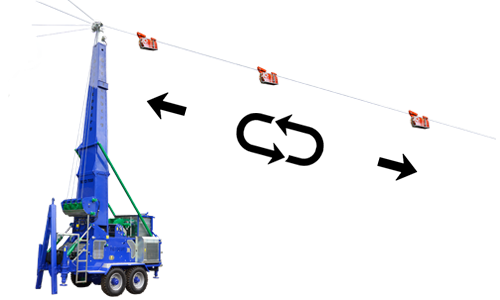
ATG, Automatic Travel Greifenberg, is the electronic control and management system, a true form of artificial intelligence, meaning the machine's ability to travel along the rope autonomously and in automatic cycles. The ATG system takes into account various critical points such as supports, potential load entanglements, excessive power demands uphill, overspeeding during descents, deceleration and acceleration speeds, and updating the loading point if necessary. It constantly coordinates the work with responsiveness, precision, and accuracy.
To activate ATG, the machine must first recognise the two endpoints of the line, which are stored as "start of line" and "end of line" through an intuitive procedure on the control panel. Afterward, it will be possible to store the points along the line where the supports are located, which will be interpreted as sensitive points. To ensure smooth travel, the electronic system allows the user to set how far from the support the machine should start to decelerate and how far after passing the support it should accelerate again and return to normal speed. The distances and the amount of deceleration can be set differently depending on which direction the journey is taking and, consequently, how the machine enters the supports. When transporting heavy loads downhill, gradual deceleration is necessary at an appropriate distance, and after crossing the support, the machine quickly picks up speed again to avoid rope and load oscillation. Conversely, if the transport is going uphill, deceleration is only needed close to the support since the weight and gravity already enhance deceleration.
Everything is under control during the journey. The machine, thanks to its pressure transducers and position encoders, continuously monitors the effort and, if it detects any abnormal peaks (caused by jamming or friction), it deactivates the automatic system, halting the journey but always making manual mode available. The ATG function also allows the loading or unloading point to be updated via the radio control. When the transport often needs to change its destination to pick up or drop off material at different locations, the user can simply activate the “store new end point” function directly from the remote control, and the machine will stop exactly at the designated spot.
Smart Yarder
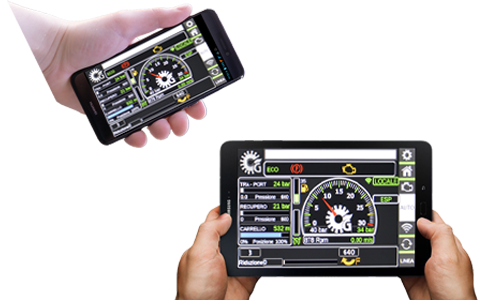
Information is everything. The “Smart Yarder” function, in addition to keeping you informed about everything your machine is doing, allows you to interact remotely directly from your smartphone, tablet, or PC. Smart Yarder faithfully replicates everything the Greifenberg infotainment system communicates through the machine’s touchscreen panel. Every single piece of information is transmitted and replicated accurately on your device. But not only that – you can write or modify settings and work programmes. It is a “mirroring” system that duplicates the control point without needing to access the machine. This innovation was introduced specifically to facilitate the adjustment of work parameters and to monitor the machine’s status, such as the engine speed, fuel level, or AdBlue level. Access to this function is protected by a password to prevent external access. You simply need to activate the Wi-Fi function on your portable device and enter the secret code.
The machine, thanks to a powerful router with an emitting antenna, remains constantly connected within a range of about 50 metres. This function is particularly appreciated by those operating both the Greifenberg equipment and another vehicle, such as a tractor, skidder, harvester, or excavator. No more getting in and out of your vehicle! Online controls, checks, and parameter settings allow you to stay in your control seat, increasing comfort and productivity.
Touch Screen Display
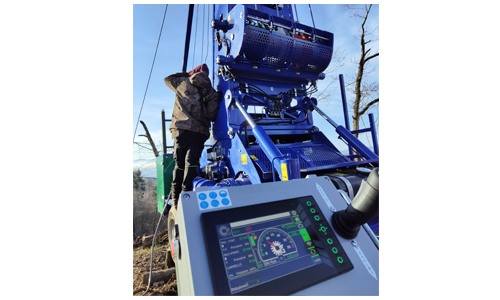
This type of display is at the top of its performance in terms of technology and reliability. It is resistant to weather conditions such as rain and snow. It has a high brightness level to ensure excellent visibility even when exposed to sunlight, with outstanding definition and realistic colours that enhance readability, even from very oblique viewing angles. The touchscreen is patented for use even with gloves. Additionally, all work menus can also be accessed via physical buttons to change screens. Every process is under control. It allows the display of data and the setting of machine parameters with maximum flexibility. From the control display, it is possible to select engine power, view fuel and AdBlue levels, hydraulic system pressure, the speed and position of the carriage, the position and speed of each roller, check the brake status, which roller is active, display alarms, machine maintenance status, and much more.
The line parameters can be entered using factory data or can be customised in detail. For example, deceleration during the crossing of shoes can be specified according to the direction of entry, whether uphill or downhill, and programmed in both distance and deceleration percentage. There are infinite possibilities for use, intuitive, quick, and adaptable to different situations to tackle all types of daily tasks.
Eco Power
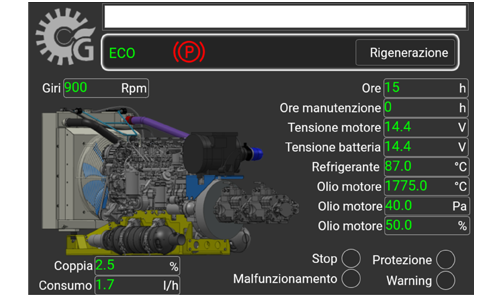
Power only when needed. Greifenberg machines are equipped with powerful engines to ensure they never stop and to perform transport tasks more efficiently, reducing time and increasing daily productivity. Oversized engines with high torque, even at low rpm, allow both high power output and sufficient torque for low-rpm hydrostatic systems. The Eco Power system is a control for the engine’s power output, rpm, and the mapping of pump flow rates. The selection of the three available modes—Eco Power, Normal Power, and Full Power—adapts the engine and hydrostatic transmission characteristics to the needs of your site.
If the loads are light and full power is not needed, the "Eco Power" mode is selected. This setting, besides being "eco-friendly" by reducing both noise and exhaust emissions, allows fuel savings of up to 40%, resulting in lower costs and higher profitability. The "Normal Power" setting partially limits the diesel engine's power and optimises the pump flow rates to ensure excellent translation speeds and strong acceleration during full-load start-up phases. Fuel consumption and emissions are limited, with an increase in working speed. This is a commonly used compromise when transportation requirements align with the machine’s average performance.
"Full Power" delivers maximum performance. All the diesel horsepower is available, providing maximum performance from the hydrostatic system. The electronics demand the highest performance from the transmission, both in speed and torque. In this operating mode, the machine offers the highest performance, with enhanced power bursts and increased translation speeds. All the available power is at your disposal, without limits.
Automatic Decelerator

The control of maximum speed and maximum performance without worries and without the risk of engine over-revving. Simple, quick, and effective. The electronic auto-decelerator system simultaneously processes the speed of the rope, engine revolutions, and the updated speed request to deliver the best performance. The operator only needs to input the maximum speed they wish to allow the machine to reach into the dedicated programme. From this point on, the speed of the electronic system, combined with the power of the hydraulic system, continuously monitors all parameters, testing the speed and making continuous adjustments.
The result is a smooth and constant speed control, regardless of the load's inclination. Even sudden variations, such as overcoming the peaks/shoes, are carried out with extreme caution, without jerking or jolting the ropes. The Greifenberg auto-retarder has now reached its third generation and has achieved a level of advanced automation that makes every transport faster and safer. In addition to the electronic management, the operator can manually activate the hydraulic retarder at any time to slow the descent, using the proportionality of the joystick.
Air transportable
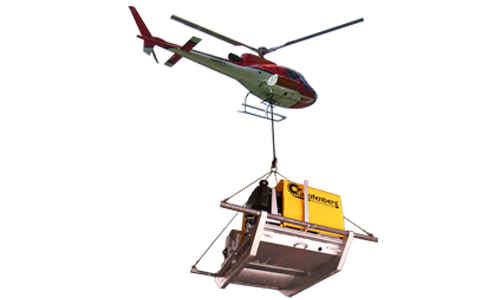
Machines and equipment by Greifenberg that need to reach work positions without communication routes are designed with modular sections for quick disassembly, creating units that weigh less than 1100 kg. This feature allows transportation using conventional helicopters. Helicopter transport reduces installation times, and the disassembly/assembly systems of the individual modules are designed to be simple, enabling the team to move the equipment quickly and safely.
Backup Alarm
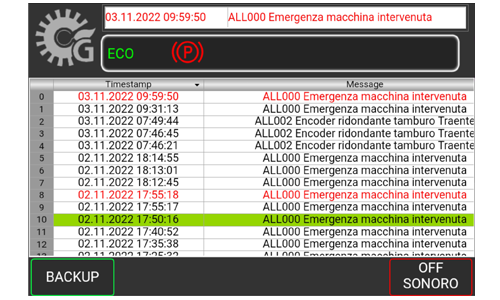
Total control, verification, and statistics. Every alarm, abnormal use, and operation outside the parameters are automatically recorded and stored in a dedicated memory. Data such as engine over-revving, overpressures, overspeed, oil and water temperature alarms, etc., are immediately recorded. It will be easy for the owner to monitor how the machine is used, both by their own staff and in the case of rental to third parties. Even for technical service interventions, everything becomes faster, limiting management costs. Information serving the durability and maintenance.
Remote Assistance
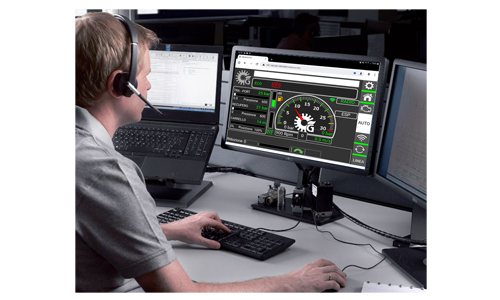
Our technicians with you, whenever you need, at your site to help you solve problems. Through remote assistance, simply activate a GPRS connection and allow access to your equipment. This always happens and exclusively with the operator's authorisation to the machine. Once connected, our electronic and hydraulic technicians can work on the machine as if they were right there on site. Maximum intervention speed and reduction of costs and waiting times. The innovation of safety always by your side.
The VFE 2000 winch is the largest in the VFE range, with a solid, large drum that allows for lines up to 1500 metres in length and ensures long-lasting performance for the mounted rope. With the VFE 2000, loads can be towed, lifted, and transported uphill or downhill. The powerful diesel engine is housed within the machine's steel frame and is protected by soundproof casing to safeguard the operator. The machine is easily positioned, as the sled frame is equipped with a front rope guide bar to assist with off-road self-dragging. Additionally, the machine can be quickly disassembled into three parts for transport to high altitudes via helicopter.
Using the proportional joystick, the operator manoeuvres the winch with a single command, controlling the hydraulic transmission and adjusting the drum speed while simultaneously increasing the diesel engine RPM. The machine is equipped with a hydraulic deceleration pump on the diesel engine, allowing it to descend at higher speeds without the risk of the engine over-revving. There is also an additional manual double-clamp safety brake on the drum. The VFE 2000 can be customised with "Greifenberg Technology," offering various optional accessories to optimise productivity in terms of time, quantity, quality, and cost.

A 2750 mm
B 1250 mm
C 1400 mm
| TECHNICAL DATA | |
|---|---|
| Winch type | Steel skid frame |
| Diesel engine power | 74 kw / 101 cv |
| Hydraulic system | Dual Linde pump with a closed circuit |
| Control management | Hydraulics |
| Indicative dry weight | 2,3 ton |
| Dismountable for air transport | 3 parts |
| PULLING DRUM | |
| Rope capacity and diameter | 2100 m d. 11 mm |
| Rope capacity and diameter | 1800 m d. 12 mm |
| Tensile strength at the first layer of the rope | 6100 daN |
| Tensile strength at the last layer of the rope | 3500 daN |
| Maximum speed at the last layer of the rope | 6,7 m/s |
Air transportable

Greifenberg machines and equipment that need to reach work positions without communication routes are designed with modular sections for quick disassembly, allowing the creation of units with a weight of less than 1100 kg. This feature makes it possible to transport them using conventional helicopters. Air transport reduces installation times, and the disassembly/assembly systems of the individual modules are designed to be simple, enabling the team to move the equipment quickly and safely.
The VF 1500 Freeman winch allows the construction of lines up to 1400 metres and provides a power output of 102 hp with its turbo diesel engine. The steel frame is soundproofed for greater comfort for the winch operator, while the aluminium casing reduces the machine’s weight. It can be disassembled into two parts for helicopter transport: one with the frame and drum, and the other with the engine body, including electrical and hydraulic systems. The robustness and large diameter of the drum ensure a long lifespan for the mounted cable, and loads can be towed, lifted, and transported uphill or downhill.
The VF 1500 Freeman winch allows the line parameters to be saved via the touch screen panel, which can be positioned remotely. It is equipped with a hydraulic deceleration pump on the diesel engine, enabling descent at higher speeds without the risk of the diesel engine exceeding its safe operating speed. In terms of safety, the winch features a manual hydraulic brake on the drum, to be used only in the event of anomalies or malfunctions.
Additionally, the machine can be customised with Greifenberg Technology, offering a variety of optional accessories that optimise the machine’s potential.

A 2700 mm
B 1270 mm
C 1670 mm
| TECHNICAL DATA | |
|---|---|
| Winch type | Steel skid frame |
| Diesel engine power | 74 kw / 101 cv |
| Hydraulic system | Dual Linde pump with a closed circuit |
| Control management | Electronics |
| Indicative dry weight | 1,9 ton |
| Dismountable for air transport | 3 parts |
| PULLING DRUM | |
| Rope capacity and diameter | 1500 m d. 11 mm |
| Rope capacity and diameter | 1350 m d. 12 mm |
| Tensile strength at the first layer of the rope | 4780 daN |
| Tensile strength at the last layer of the rope | 3100 daN |
| Maximum speed at the last layer of the rope | 6 m/s |
| RETARDER | |
| Power | 58 kw - 80 cv |
| Retarder control | Automatic and manual intervention |
Radio System

The radio controllers used by Greifenberg are the result of years of field experience in terms of operating range and user ergonomics. They are easily usable with protective gloves, featuring an extremely robust "case" that can withstand falls and heavy impacts. With a convenient shoulder strap, they can be handled with one hand, and thanks to buttons marked with specific icons, operations during use are extremely simple. A powerful battery ensures operation for a full working day; additionally, the standard supply includes a spare battery and a charger. The brain of the radio system is located in the key inserted into the remote, where communication codes and protocols are stored.
From the remote control, all the operations that are normally carried out on the machine's touchscreen panel can be performed. For instance, it allows turning the diesel engine on and off, adjusting the speed of the ropes, setting and updating the end line or load point, performing movements outside the set parameters using the dedicated "bypass" button, starting the automatic work cycle to operate the machine autonomously, controlling traditional trolleys by opening and closing the blocks on the ropes, and performing all operations on motorised trolleys, controlling both the motor and the lifting and lowering speed. Through the remote control, the maximum lifting point of the trolley can be set to prevent the hook from being lifted too much, as well as the maximum unwinding of the rope, preventing the entire rope from unwinding from the trolley's drum. If the rope is shortened, the maximum lifting point can be reset according to the new rope length. The same remote can also integrate the management of Fortronics electronic chokers with an anti-accidental opening system.
The Radio System includes a perfectly coded and integrated radio frequency repeater. The radio controllers can operate with one or more repeaters, allowing infinite working distances, and especially overcoming bumps, buildings, and any kind of obstacles, extending the operational range. The repeater is housed in a robust, compact casing, and inside, a powerful rechargeable battery ensures operation throughout an intense working day. The repeater must be placed at the top of bumps or beside structures to ensure a good connection both with the transmitter and the receiver. The activation is very simple and is performed with a single button, and the distance is reset with a click.
Greifenberg understands external working conditions, with temperatures ranging from sub-zero to scorching sun, snow, water, and humidity. The Radio System is weatherproof: IP65 rated, with selected components, and contacts treated with anti-oxidant materials; these are the guarantees of a product designed for heavy-duty use. Maximum reliability ensures precise, timely, and unquestionable commands. Transmitters, repeaters, and receivers are ready for continuous work.
Automatic Cycle

ATG, Automatic Travel Greifenberg, is the electronic control and management system, a true form of artificial intelligence, meaning the machine's ability to perform rope travel autonomously and in automatic cycle. The ATG system takes into account various critical points such as supports, potential load entanglements, excessive power demand uphill, over-revving during descents, deceleration and acceleration speeds, and the updating of the load point if necessary. It constantly coordinates the work with reactivity, precision, and accuracy.
To activate the ATG, it is necessary to register the two extreme points of the line, which are stored as "start line" and "end line" using an intuitive procedure on the control panel. Subsequently, it will be possible to store the points along the line where the supports are located, which will be interpreted as sensitive points. To achieve smooth translation, the electronic system allows you to set at which distance from the support you want to slow down and at which distance, after passing the support, you want to accelerate again and return to normal speed. The distances and the amount of deceleration can be set differently depending on which part of the journey you are on and, consequently, the entry onto the supports. For example, when transporting heavy loads downhill, it is necessary to slow down gradually from a safe distance, while once the support is passed, speed is quickly regained to avoid rope and load oscillations. On the other hand, if the transport is uphill, it is sufficient to slow down close to the support since the weight and gravity already provide natural deceleration.
Everything is under control during the journey. The machine, thanks to its pressure transducers and position encoders, constantly monitors the effort and, if abnormal peaks are detected (caused by jamming or contrasts), deactivates the automatic system, stopping the journey but always keeping manual mode available. The ATG function also allows for the load or unload point to be updated via radio control. When the transport needs to frequently change the destination point to pick up or deposit materials in different locations, simply activate the "store new end point" function directly from the remote control, and the machine will stop its journey exactly at the determined location.
Smart Yarder

Information is everything. The "Smart Yarder" function, in addition to keeping you informed about everything your machine is doing, allows you to interact remotely via your smartphone, tablet, or PC. Smart Yarder precisely replicates everything the Greifenberg infotainment system communicates through the machine’s touchscreen panel. Every single piece of information is transmitted and faithfully replicated on your device. Not only that, it is possible to write or modify settings and work programmes. A “mirroring” system that duplicates the control point without needing access to the machine itself. This innovation has been introduced specifically to ease the adjustment of work parameters and monitor the status of the machine, such as the engine's RPM or the fuel or AdBlue levels. Access to this function is protected by a password to prevent external access. Simply activate the Wi-Fi function on your portable device and enter the secret code.
The machine, thanks to a powerful router with a transmitting antenna, remains in constant connection within a range of approximately 50 metres. This feature is particularly appreciated by those operating both the Greifenberg equipment and other machinery, such as tractors, skidders, harvesters, or excavators. No more getting on and off your vehicle! Online controls, checks, and parameter settings allow you to stay at your command post, increasing both comfort and productivity.
Touch Screen Display

This type of display is at the top of its performance in terms of technology and reliability. It is resistant to weather conditions such as rain and snow. It has a high brightness level to ensure excellent visibility even when exposed to sunlight, with outstanding definition and realistic colours that enhance readability, even from very oblique viewing angles. The touchscreen is patented for use even with gloves. Additionally, all work menus can also be accessed via physical buttons to change screens. Every process is under control. It allows the display of data and the setting of machine parameters with maximum flexibility. From the control display, it is possible to select engine power, view fuel and AdBlue levels, hydraulic system pressure, the speed and position of the carriage, the position and speed of each roller, check the brake status, which roller is active, display alarms, machine maintenance status, and much more.
The line parameters can be entered using factory data or can be customised in detail. For example, deceleration during the crossing of shoes can be specified according to the direction of entry, whether uphill or downhill, and programmed in both distance and deceleration percentage. There are infinite possibilities for use, intuitive, quick, and adaptable to different situations to tackle all types of daily tasks.
Eco Power

Power only when needed. Greifenberg machines are equipped with powerful engines that never stop and enable transportation while reducing time and increasing daily productivity. Oversized engines with high torque, even at low RPM, allow for both high power output and sufficient torque for low-speed hydrostatic systems. The Eco Power system controls the engine power delivery, RPM, and the pump flow mapping. The selection of three available modes—Eco Power, Normal Power, and Full Power—adapts the engine and hydrostatic transmission characteristics to the specific needs of your site.
If the loads are light and full power isn't required, the “Eco Power” mode is selected. This setting, in addition to being "eco-friendly" by reducing both noise and exhaust emissions, allows for up to 40% fuel savings, reducing costs and increasing profitability. The "Normal Power" setting partially limits the diesel power and optimises pump flows, allowing for excellent travel speeds and great acceleration during full-load start-up phases. Consumption and emissions are limited while work speed increases. This is a commonly used compromise when transportation needs align with the machine’s average performance.
“Full Power” provides maximum performance. All the diesel power available, maximum performance from the hydrostatic system, and the electronics demand the most from the transmission in both speed and torque. In this operating mode, the machine delivers peak performance with greater force output and increased travel speeds. All the available power at your fingertips, without limits.
Automatic Decelerator

The control of maximum speed and maximum performance without worries and without the risk of engine over-revving. Simple, quick, and effective. The electronic auto-decelerator system simultaneously processes the speed of the rope, engine revolutions, and the updated speed request to deliver the best performance. The operator only needs to input the maximum speed they wish to allow the machine to reach into the dedicated programme. From this point on, the speed of the electronic system, combined with the power of the hydraulic system, continuously monitors all parameters, testing the speed and making continuous adjustments.
The result is a smooth and constant speed control, regardless of the load's inclination. Even sudden variations, such as overcoming the peaks/shoes, are carried out with extreme caution, without jerking or jolting the ropes. The Greifenberg auto-retarder has now reached its third generation and has achieved a level of advanced automation that makes every transport faster and safer. In addition to the electronic management, the operator can manually activate the hydraulic retarder at any time to slow the descent, using the proportionality of the joystick.
Air transportable

Machines and equipment by Greifenberg that need to reach work positions without communication routes are designed with modular sections for quick disassembly, creating units that weigh less than 1100 kg. This feature allows transportation using conventional helicopters. Helicopter transport reduces installation times, and the disassembly/assembly systems of the individual modules are designed to be simple, enabling the team to move the equipment quickly and safely.
Backup Alarm

Total control, verification, and statistics. Every alarm, abnormal use, and operation outside the parameters are automatically recorded and stored in a dedicated memory. Data such as engine over-revving, overpressures, overspeed, oil and water temperature alarms, etc., are immediately recorded. It will be easy for the owner to monitor how the machine is used, both by their own staff and in the case of rental to third parties. Even for technical service interventions, everything becomes faster, limiting management costs. Information serving the durability and maintenance.
Remote Assistance

Our technicians with you, whenever you need, at your site to help you solve problems. Through remote assistance, simply activate a GPRS connection and allow access to your equipment. This always happens and exclusively with the operator's authorisation to the machine. Once connected, our electronic and hydraulic technicians can work on the machine as if they were right there on site. Maximum intervention speed and reduction of costs and waiting times. The innovation of safety always by your side.
TopLine is Greifenberg's range of "civil" hydraulic winches, characterised by great pulling force and extreme precision in movements for the exact placement of transported loads. When equipped with a capstan, the winch becomes the driving station of a closed-loop line for transport uphill, downhill, and on flat terrain. The frame, engine cover, casing, and protective guards are made of steel, and the robust, large-diameter drum ensures the long lifespan of the onboard rope.
The TopLine 1800 is powered by a large-displacement turbo diesel engine. The electronic-controlled hydrostatic transmission, combined with a negative brake and an additional hydraulic pin brake, ensures proper load locking. It also features an emergency braking system with a manually operated independent hydraulic pump. The console control panel can be positioned up to 10 metres away, providing the operator with a safer position and better visibility of the line.
Through line parameterisation, it is possible to set the loading and unloading points as well as deceleration zones for passing over support shoes; at these points, the winch will slow down automatically without requiring any operator input. The display continuously informs the operator of the engine status, RPM, instant fuel consumption, delivered torque, oil pressure and temperature, coolant temperature, and pulling force. With numerous configuration options and additional features, the TopLine 1800 is a versatile machine and stands out for its high load capacities.

A 2750 mm
B 1480 mm
C 1780 mm
| TECHNICAL DATA | |
|---|---|
| Winch type | Steel skid frame |
| Diesel engine power | 115 kw / 156 cv |
| Hydraulic system | Dual Linde pump with a closed circuit |
| Control management | Electronics |
| Indicative dry weight | 3,5 ton |
| Dismountable for air transport | 5 parts |
| PULLING DRUM | |
| Rope capacity and diameter | 1800 m d. 16 mm |
| Rope capacity and diameter | 1600 m d. 18 mm |
| Tensile strength at the first layer of the rope | 7200 daN |
| Tensile strength at the last layer of the rope | 5000 daN |
| Maximum speed at the last layer of the rope | 3,5 m/s |
| RETARDER | |
| Power | 58 kw - 80 cv |
| Retarder control | Automatic and manual intervention |
Radio System

The radio controls adopted by Greifenberg are the result of years of field experience concerning operational capacity and user ergonomics. They are conveniently usable with safety gloves, featuring an extremely robust "case" capable of withstanding drops and violent impacts. With the convenient shoulder strap, they can be held with one hand, and thanks to the buttons marked with specific icons, operations during use are extremely simple. A powerful battery guarantees operation for an entire working day, and additionally, the standard supply also includes a spare battery and a charger. The brain of the radio system is located in the key inserted into the remote control, where communication codes and protocols are stored.
From the remote control, it is possible to carry out all the operations normally performed from the machine's touch screen panel. In fact, it is possible to turn the diesel engine on and off, increase or decrease the speed of the ropes, set and update the end of the line or loading point, make adjustments outside the set parameters using the dedicated "by-pass" button, start the automatic work cycle to operate the machine autonomously, control traditional trolleys by opening and closing the blocks on the ropes, and also perform all operations on motorised trolleys by controlling both the motor and the lifting and lowering speed. Through the remote control, it is possible to set the maximum lifting point of the trolley so that the hook is not incorrectly raised too much, as well as the maximum unwinding of the rope, preventing the entire rope from being unwound from the trolley's drum. If the rope is shortened, it is possible to reset the maximum lifting point to update it to the new rope length. The same remote control can also integrate the management of Fortronics electronic shockers with an anti-accidental opening system.
The Radio System includes a perfectly coded and integrated radio frequency repeater. The remote controls can operate with one or more repeaters, allowing for an infinite working distance and, above all, enabling the overcoming of bumps, buildings, and any kind of obstacle, extending the operating range. The repeater is housed in a robust, small-sized casing, and inside it, a powerful rechargeable battery ensures operation even during a long working day. The repeater must be placed on the peaks of bumps or alongside structures to ensure good connectivity with both the transmitter and the receiver. Activation is very simple, performed with a single button, and the distance is reset with a click.
Greifenberg understands the external working conditions, with temperatures ranging from below freezing to scorching sun, snow, water, and humidity. The Radio System is not affected by the weather: IP 65 rating, selected components, contacts treated with anti-corrosive materials—these are the guarantees of a product designed for heavy-duty use. Maximum reliability ensures precise, timely, and irrefutable commands. Transmitters, repeaters, and receivers are ready for uninterrupted operation.
Automatic Cycle

ATG, Automatic Travel Greifenberg, is the electronic control and management system, a true form of artificial intelligence, meaning the machine's ability to travel along a rope completely autonomously and in automatic cycle. The ATG system considers various critical points such as supports, potential load entanglements, excessive power demand when going uphill, overspeed during descents, deceleration and acceleration speeds, and updates to the loading point if necessary. It constantly coordinates the work with reactivity, precision, and accuracy.
To activate the ATG, it is necessary to teach the machine the two endpoints of the line, which are stored as the "start of the line" and "end of the line" using an intuitive procedure on the control panel. Then, it will be possible to store the points along the line where the supports are located, which will be interpreted as sensitive points. To achieve linear travel, the electronic system allows setting the distance at which we want to decelerate from the support and at what distance after passing the support we want to accelerate and return to normal speed. The distances and amount of deceleration can be set differently depending on which part of the journey is being made and how the entry to the supports is approached. For example, when carrying heavy loads downhill, it is necessary to gradually slow down at an appropriate distance, and after passing the support, the machine will quickly regain speed to avoid rope and load oscillations. Conversely, if the transport is uphill, it is enough to slow down close to the support as the weight and gravity already contribute to deceleration.
Everything is under control during the journey. The machine, thanks to its pressure transducers and position encoders, constantly monitors the effort. If it detects abnormal peaks (caused by snags or contrasts), it deactivates the automatic system, halting the journey while still allowing manual mode. The ATG function also allows updating the loading or unloading point via the radio control. When the transport needs to frequently change the arrival point to pick up or drop off material at different locations, simply activate the “store new end point” function directly from the remote control, and the machine will stop exactly at the specified location.
Smart Yarder

Information is everything. The "Smart Yarder" function, in addition to keeping you informed about everything your machine is doing, allows you to interact remotely directly from your smartphone, tablet, or PC. Smart Yarder accurately replicates everything that the Greifenberg infotainment system communicates through the machine's touch screen. Every single piece of information is transmitted and faithfully replicated on your device. But that's not all; it is also possible to write or modify settings and work programmes. A "mirroring" system that splits the control point without needing to access the machine itself. This innovation was introduced specifically to facilitate the adjustment of work parameters and to monitor the machine's status, such as the engine's rpm, fuel level, or AdBlue level. Access to this function is protected by a password to prevent external access. It is enough to activate the Wi-Fi function on your portable device and enter the secret code.
The machine, thanks to a powerful router with a transmitting antenna, remains constantly connected within a range of approximately 50 metres. This function is particularly appreciated by those who operate both Greifenberg equipment and another machine, such as a tractor, skidder, harvester, or excavator. Never again will you need to get in and out of your vehicle! Online controls, checks, and configurations allow you to stay at your command post, increasing comfort and productivity.
Touch Screen Display

This type of display is at the top in terms of technology and reliability. It is weather-resistant, capable of withstanding rain and snow, and offers high brightness for excellent visibility even when exposed to direct sunlight. The display also boasts excellent definition with realistic colours that make reading easy, even at very oblique angles. The touchscreen is patented for use even with gloves, and all work menus can be accessed through physical buttons to change the screen view.
Every process is under control. It allows you to view data and set the machine’s parameters with maximum flexibility. From the control display, you can select the engine power, monitor fuel and AdBlue levels, check hydraulic system pressure, track the speed and position of the trolley, view the position and speed of each roller, check the brake status, see which roller is active, view alarm notifications, check the machine's maintenance status, and much more.
The line parameters can be entered with factory settings or can be traced in detail. For instance, slowing down when crossing shoes can be customised according to the direction of travel, whether uphill or downhill, and can be programmed both in distance and as a percentage of slowdown. There are infinite possibilities for use—intuitive, fast, and adaptable to various situations to tackle any daily activity.
Eco Power

Power only when you need it. Greifenberg machines are equipped with powerful engines that never stop, enabling efficient transport while reducing time and increasing daily productivity. Over-sized engines with high torque at low RPM allow for both high power output and sufficient torque for hydrostatic systems operating at low revolutions. The Eco Power system controls engine power delivery, RPM, and pump flow mapping. The selection of three available modes—Eco Power, Normal Power, and Full Power—adjusts the engine and hydrostatic transmission characteristics to suit your worksite needs.
If the loads are light and full power is not required, the “Eco Power” mode can be selected. This setting, in addition to being eco-friendly by reducing both noise and exhaust emissions, also saves up to 40% in fuel consumption, leading to lower costs and higher profitability. The “Normal Power” setting partially limits the diesel power and optimizes the pump flow rates, providing excellent translation speeds and strong acceleration during startup with a full load. Fuel consumption and emissions are kept low while work speed is increased—this is the most commonly used setting when transport needs align with the machine's average performance.
“Full Power” mode delivers the maximum performance. All the diesel power is available, and the hydrostatic system operates at peak performance, with the electronics demanding the most from the transmission in both speed and torque. The machine offers the highest performance in this mode, with greater power bursts and increased translation speeds. All the available power is at your fingertips, without limits.
Automatic Decelerator

The control of maximum speed and performance without worries or the risk of engine over-revving. Simple, fast, and effective. The electronic auto-retarder system simultaneously processes the speed of the cable, engine RPM, and the current speed request to provide the best performance. The operator only needs to set the maximum speed they wish to allow for the machine in the dedicated program. From that point on, the speed control system, combined with the power of the hydraulic system, constantly monitors all parameters, testing the speed and making continuous adjustments.
The result is a smooth and consistent control of speed, regardless of the load's incline. Even sudden changes, like crossing over the peaks or shoes, are handled with great care, avoiding jerks or shocks to the ropes. Greifenberg's auto-retarder is now in its third generation and has reached an advanced level of automation, making every transport faster and safer. In addition to the electronic management, the operator can manually engage the hydraulic retarder at any time to slow down the descent using the proportionality of the joystick.
Air transportable

Greifenberg machines and equipment that need to reach work positions without communication routes are designed with modular sections for quick disassembly, allowing the creation of units with a weight of less than 1100 kg. This feature makes it possible to transport them using conventional helicopters. Air transport reduces installation times, and the disassembly/assembly systems of the individual modules are designed to be simple, enabling the team to move the equipment quickly and safely.
Backup Alarm

Total control, verification, and statistics. Every alarm, abnormal use, and operation outside the parameters are automatically recorded and stored in a dedicated memory. Data such as engine over-revving, overpressures, overspeed, oil and water temperature alarms, etc., are immediately recorded. It will be easy for the owner to monitor how the machine is used, both by their own staff and in the case of rental to third parties. Even for technical service interventions, everything becomes faster, limiting management costs. Information serving the durability and maintenance.
Remote Assistance

Our technicians with you, whenever you need, at your site to help you solve problems. Through remote assistance, simply activate a GPRS connection and allow access to your equipment. This always happens and exclusively with the operator's authorisation to the machine. Once connected, our electronic and hydraulic technicians can work on the machine as if they were right there on site. Maximum intervention speed and reduction of costs and waiting times. The innovation of safety always by your side.
The VF Freeman is the top-of-the-range forest winch series from Greifenberg. Its frame is entirely made of Ergal aluminum alloy, known for its excellent mechanical resistance, light weight, and robust construction. The sliding skids are made from Hardox steel, which offers exceptional wear resistance, and the engine cover can be easily opened for routine maintenance and checks.
The modular design makes it suitable for helicopter transport, as it can be divided into three parts, ensuring easy and quick connection and repositioning. This design provides a unique and exclusive identity to the winch, giving it a strong character. It is capable of creating lines up to 1800 meters in length, combining both high mechanical performance and cutting-edge technological applications.
The winch features a turbo diesel engine, a Linde variable displacement pump, and an axial piston hydraulic motor. It also includes an additional Load-Sensing hydraulic pump, which acts as a retarder, automatically engaging at pre-set thresholds during downhill operation. This allows for high speeds without compromising the performance of the diesel engine.
The winch is equipped with an automatic oil bath disc service brake and a hydraulic system using biodegradable hydraulic oil.
The control panel with an integrated screen displays essential data and parameters. It enables the programming of speed, the positioning of the support vertices, and the end-of-travel positions for the line.

A 3620 mm
B 1630 mm
C 1420 mm
| TECHNICAL DATA | |
|---|---|
| Winch type | Steel skid frame |
| Diesel engine power | 74 kw / 101 cv |
| Hydraulic system | Dual Linde pump with a closed circuit |
| Control management | Electronics |
| Indicative dry weight | 1,9 ton |
| Dismountable for air transport | 3 parts |
| PULLING DRUM | |
| Rope capacity and diameter | 1750 m d. 11 mm |
| Rope capacity and diameter | 1450 m d. 12 mm |
| Tensile strength at the first layer of the rope | 4780 daN |
| Tensile strength at the last layer of the rope | 3100 daN |
| Maximum speed at the last layer of the rope | 6 m/s |
| RETARDER | |
| Power | 58 kw - 80 cv |
| Retarder control | Automatic and manual intervention |
Radio System

The radio controls adopted by Greifenberg are the result of years of field experience in terms of operating range and user ergonomics. They can be comfortably used with safety gloves and feature an extremely robust case capable of withstanding drops and heavy impacts. With a convenient shoulder strap, they can be operated with one hand, and thanks to the buttons marked with specific icons, operations during use are extremely simple. A powerful battery guarantees operation for an entire working day. Additionally, the standard supply also includes a spare battery and a charger.
The brain of the radio system is found in the key inserted into the remote, where codes and communication protocols are stored. From the remote control, it is possible to carry out all the operations normally performed from the machine's touch screen panel. Specifically, it allows turning the diesel engine on and off, increasing and decreasing the speed of the ropes, setting and updating the end line or loading point, making movements outside the set parameters thanks to the dedicated "by-pass" button, starting the automatic work cycle for the machine to operate autonomously, controlling traditional trolleys by opening and closing the blocks on the ropes, and also performing all the operations on motorised trolleys, controlling both the motor and the lifting and lowering speed.
Through the remote control, it is also possible to set the maximum lifting point of the trolley to prevent the hook from being raised too high, as well as the maximum unwinding of the rope, preventing the entire rope from being unwound from the trolley's drum. If the rope is shortened, the maximum lifting point can be reset according to the new rope length. The same remote control can also integrate the management of Fortronics electronic chokers with an accidental anti-opening system.
The Radio System includes a frequency repeater that is perfectly coded and integrated. The radio controls can operate with one or more repeaters, thus making the working distance virtually limitless and, importantly, capable of overcoming bumps, buildings, and obstacles of any kind, extending the operational range. The repeater is housed in a robust, compact casing, and inside it, a powerful rechargeable battery allows it to work for an entire working day. The repeater should be placed at the peaks of bumps or alongside structures so that it can establish a good connection with both the transmitter and receiver. The activation is very simple, performed with a single button press, and the distance can be reset with a click.
Greifenberg understands external working conditions, with temperatures ranging from below zero to scorching sun, snow, water, and humidity. The Radio System is not affected by the weather: it has an IP65 rating, selected components, and contacts treated with anti-corrosive materials. These are the guarantees of a product designed for tough work environments. Maximum reliability is ensured for precise, timely, and unquestionable commands. Transmitters, repeaters, and receivers are ready for non-stop work.
Automatic Cycle

ATG, Automatic Travel Greifenberg, is the electronic control and management system, a true form of artificial intelligence, meaning the machine’s ability to perform rope journeys autonomously and in automatic cycle. The ATG system considers various critical points such as supports, possible entanglements of the load, excessive power demands on slopes, over-revving on descents, deceleration and acceleration speeds, and updates to the loading point if necessary. It continuously coordinates the work with responsiveness, precision, and accuracy.
To activate the ATG, it is necessary to register the two end points of the line, which are stored as "start line" and "end line" through an intuitive procedure on the control panel. Subsequently, it will be possible to store points along the line where the supports are located, which will be interpreted as sensitive points. To achieve linearity in the translation, the electronic system allows you to set the distance at which to decelerate from the support, and at what distance after passing it, you wish to accelerate and return to normal speed. The distances and amount of deceleration can be input differently depending on the direction of the journey and the corresponding entry onto the supports. For instance, when carrying heavy loads downhill, it is necessary to gradually decelerate at a proper distance. After passing the support, speed is quickly restored to avoid rope and load oscillations. Conversely, if the transport is uphill, it is sufficient to decelerate near the support as the weight and gravity naturally provide the deceleration.
Everything is under control during the journey; the machine, thanks to its pressure transducers and position encoders, constantly monitors the effort, and if it detects any abnormal spikes (caused by blockages or resistance), it deactivates the automatic system, stopping the journey but always making manual mode available. The ATG function also allows updating the loading or unloading point via the radio control. When the transport often requires changing the destination point to pick up or drop off material in different locations, simply activate the "store new end point" function directly from the remote control, and the machine will stop its run exactly at the designated location.
Smart Yarder

Information is everything. The "Smart Yarder" function, in addition to keeping you informed about everything your machine is doing, allows you to interact remotely via your smartphone, tablet, or PC. Smart Yarder faithfully mirrors everything that the Greifenberg infotainment system communicates through the machine’s touchscreen. Each piece of information is transmitted and replicated precisely on your device. Not only that, but it is also possible to write or modify settings and work programmes. This "mirroring" system replicates the control point without the need to access the machine itself. This innovation was introduced specifically to facilitate adjustments of work parameters and to monitor the machine’s status, such as engine revs, fuel level, or AdBlue. Access to this function is protected by a password to prevent external access. It is simply necessary to activate the Wi-Fi function on your portable device and enter the secret code.
The machine, thanks to a powerful router with a transmitting antenna, maintains a constant connection within a range of about 50 metres. This feature is especially appreciated by those who operate both the Greifenberg equipment and another machine, such as a tractor, skidder, harvester, or excavator. No more climbing in and out of your vehicle! Remote control, verification, and online parameterisation allow you to stay at your control point, enhancing both comfort and productivity.
Touch Screen Display

This type of display is at the forefront of performance in terms of technology and reliability. It is resistant to weather conditions such as rain and snow. It offers high brightness to ensure excellent visibility, even when exposed to direct sunlight, with outstanding definition and realistic colours that enhance readability, even at very steep viewing angles. The touchscreen is patented to be used even with gloves, and additionally, all work menus can also be accessed using physical buttons to change the screen view. Every process is under control. It allows for the visualisation of data and the adjustment of machine parameters with maximum flexibility of use. From the control display, it is possible to select the engine power, view fuel and AdBlue levels, hydraulic system pressure, cart speed and position, roller position and speed, check the brake status, see which roller is active, view alarms, monitor machine maintenance status, and much more. The line parameterisation can be set with factory data, or it can be customised in detail. For example, slowdowns during the crossing of supports can be specified according to the direction of entry, whether uphill or downhill, and programmed both by distance and percentage of deceleration. There are endless usage possibilities, intuitive, fast, and adaptable to different situations, making it suitable for all types of daily operations.
Eco Power

Power only when needed. Greifenberg machines are equipped with powerful engines to ensure they never stop and can carry out transports while reducing time and increasing daily productivity. Overdimensioned engines with high torque, even at low revolutions, allow for both high power delivery and sufficient torque for hydrostatic systems at low revs. The Eco Power system controls the engine power delivery, the number of revolutions, and the pump flow mapping. The selection of the three available modes—Eco Power, Normal Power, and Full Power—adapts the engine and hydrostatic transmission characteristics to the specific needs of your job site.
If the loads are light and full engine power is not required, the "Eco Power" mode is selected. This setting, in addition to being eco-friendly by reducing both noise and exhaust emissions, enables fuel savings of up to 40%, leading to lower costs and higher profitability. The "Normal Power" setting partially limits the diesel power and optimises pump flow, allowing for excellent translation speeds and strong acceleration during full-load starts. Fuel consumption and emissions are limited while work speed is increased. This setting is commonly used when transport needs align with the machine's average performance.
"Full Power" delivers maximum performance. All the horsepower of the diesel engine is available, with maximum performance from the hydrostatic system, and the electronics push the transmission to its limits in both speed and torque. In this operating mode, the machine offers top performance, with increased power bursts and higher translation speeds. All the available power is at your fingertips, without limits.
Automatic Decelerator

The control of maximum speed and maximum performance without worries and without the risk of over-revving the internal combustion engine. Simple, fast, and effective. The electronic auto-retarder system simultaneously processes the speed of the rope, the engine revs, and the updated speed request to provide optimal performance. The operator only needs to input the maximum speed they wish to allow the machine to reach into the dedicated programme. From that point on, the speed of the electronic system, combined with the power of the hydraulic system, constantly keeps all parameters under control, testing the speed and making continuous adjustments. The result is a smooth and consistent control of the speed, regardless of the load's inclination. Even sudden variations, such as crossing peaks or shoes, are handled with great care, preventing jerks or shocks to the ropes.
The Greifenberg auto-retarder is already in its third generation and has reached a level of advanced automation that makes every transport faster and safer. In addition to the electronic management, the operator can engage the hydraulic retarder at any time to manually slow down the descent using the proportionality of the joystick.
Air transportable

Greifenberg machines and equipment that need to reach work positions without communication routes are designed with modular sections for quick disassembly, allowing the creation of units with a weight of less than 1100 kg. This feature makes it possible to transport them using conventional helicopters. Air transport reduces installation times, and the disassembly/assembly systems of the individual modules are designed to be simple, enabling the team to move the equipment quickly and safely.
Backup Alarm

Total control, verification, and statistics. Every alarm, abnormal use, and operation outside the parameters are automatically recorded and stored in a dedicated memory. Data such as engine over-revving, overpressures, overspeed, oil and water temperature alarms, etc., are immediately recorded. It will be easy for the owner to monitor how the machine is used, both by their own staff and in the case of rental to third parties. Even for technical service interventions, everything becomes faster, limiting management costs. Information serving the durability and maintenance.
Remote Assistance

Our technicians with you, whenever you need, at your site to help you solve problems. Through remote assistance, simply activate a GPRS connection and allow access to your equipment. This always happens and exclusively with the operator's authorisation to the machine. Once connected, our electronic and hydraulic technicians can work on the machine as if they were right there on site. Maximum intervention speed and reduction of costs and waiting times. The innovation of safety always by your side.
The Greifenberg TopLine series includes "civil" hydraulic winches suitable for construction and industrial sites. They are characterised by their great pulling power and extreme precision in movements, allowing for the accurate placement of loads. Thanks to the large diameter drum, the TopLine 2000 has a rope capacity of up to 2200 metres, and its remarkable sturdiness ensures the rope’s long lifespan. When equipped with a capstan, the winch becomes the driving station for a closed-loop line for transport uphill, downhill, and on flat terrain.
It is powered by a robust 6-cylinder Caterpillar turbo-diesel engine, with a Linde hydrostatic transmission and electronically controlled pump, which, along with the negative brake and an additional hydraulic pin brake, ensures proper load securing. Additionally, it is equipped with an emergency braking system with a manual hydraulic pump activation.
The movable control panel features a state-of-the-art screen from which the machine and line parameters can be configured. The winch operator has the option to store the line for the placement of support points, line extremities, loading and unloading points, and deceleration on the support shoes. This way, the winch will automatically slow down without the operator's intervention. Moreover, the diesel engine speed can be set and programmed using the Eco Power device, which manages the power to reduce CO2 emissions and fuel consumption.
Thanks to the various configuration possibilities and optional features, the TopLine 2000 is the ideal winch for the most demanding applications.

A 3700 mm
B 1780 mm
C 1880 mm
| TECHNICAL DATA | |
|---|---|
| Winch type | Steel skid frame |
| Potenza motore diesel | 125 kw / 306 cv |
| Hydraulic system | Dual Linde pump with a closed circuit |
| Control management | Electronics |
| Indicative dry weight | 5 ton |
| Dismountable for air transport | 6 parts |
| PULLING DRUM | |
| Rope capacity and diameter | 2000 m d. 18 mm |
| Rope capacity and diameter | 1600 m d. 20 mm |
| Tensile strength at the first layer of the rope | 9600 daN |
| Tensile strength at the last layer of the rope | 6000 daN |
| Maximum speed at the last layer of the rope | 3,5 m/s |
| RETARDER | |
| Power | 58 kw - 80 cv |
| Retarder control | Automatic and manual intervention |
Radio System

The radio controls used by Greifenberg are the result of years of field experience, focusing on operational range and ergonomic usability. They are comfortably usable even with safety gloves, featuring an extremely robust “case” capable of withstanding falls and violent impacts. With a convenient shoulder strap, they can be held with one hand, and, thanks to buttons marked with specific icons, the manoeuvres during use are exceptionally simple. A powerful battery guarantees a full day of operation, and the standard supply also includes a spare battery and a charger. The brain of the radio system is found in the key inserted into the remote, where codes and communication protocols are stored.
From the remote control, it is possible to perform all the manoeuvres typically done on the machine's touch screen panel. These include turning the diesel engine on and off, increasing or decreasing the rope speed, setting and updating the line end or loading point, making movements outside the set parameters via the dedicated “bypass” button, starting the automatic work cycle for the machine to operate autonomously, controlling the traditional trolleys by opening and closing the blocks on the ropes, and performing all manoeuvres on the motorised trolleys by controlling both the motor and the lifting and lowering speed. Through the remote, it is also possible to set the maximum lifting point of the trolley to ensure the hook is not erroneously raised too high, as well as the maximum rope deployment to avoid unwinding the entire rope wound on the trolley’s drum. If the rope is shortened, the maximum lifting point can be reprogrammed to match the new rope length. The same remote control can also integrate the management of Fortronics electronic chokers with an anti-accidental opening system.
The Radio System includes a perfectly encoded and integrated frequency repeater. The remote controls can operate with one or more repeaters, making the working distance virtually unlimited and, more importantly, capable of overcoming bumps, buildings, and obstacles of all kinds, extending operational distances. The repeater is housed in a small, robust enclosure, and inside, a powerful rechargeable battery ensures continuous work even on an intense workday. The repeater should be placed at the crest of bumps or alongside structures to ensure a good connection both to the transmitter and receiver. The activation is very simple, done with a single button press, and the distance can be reset with a click.
Greifenberg understands the external working conditions with temperatures ranging from below freezing to intense sunlight, snow, water, and humidity. The Radio System is built to withstand the elements: with an IP 65 rating, selected components, and contacts treated with anti-oxidant materials, these are the guarantees of a product designed for heavy-duty use. Maximum reliability ensures precise, timely, and undeniable commands. Transmitters, repeaters, and receivers are ready for uninterrupted work.
Automatic Cycle

ATG, Automatic Travel Greifenberg, is the electronic control and management system, a true form of artificial intelligence, meaning the machine's ability to perform rope travel autonomously and in automatic cycles. The ATG system takes into account various critical points such as supports, potential load snags, excessive power demand when travelling uphill, overspeeding during descents, deceleration and acceleration speeds, and the updating of the load point if necessary. It constantly coordinates the work with reactivity, precision, and accuracy.
To activate ATG, it is necessary to have the machine recognise the two endpoints of the line, which are saved as "start line" and "end line" through an intuitive procedure on the control panel. Subsequently, it will be possible to store points along the line where the supports are located, which will be interpreted as sensitive points. To achieve a smooth translation, the electronic system allows the user to set the distance from the support where deceleration should begin and at what distance, after passing the support, to reaccelerate and return to the regular speed. Distances and the amount of deceleration can be set differently depending on which part of the journey is being undertaken and, consequently, how the machine enters the supports. When transporting heavy loads downhill, it is necessary to gradually decelerate at an appropriate distance, and after passing the support, speed is quickly regained to avoid rope and load oscillations. Conversely, when the transport is uphill, it is sufficient to slow down near the support since the weight and gravity already contribute to deceleration.
Everything is under control during the journey. Thanks to its pressure transducers and position encoders, the machine constantly monitors the effort, and if it registers abnormal peaks (due to snags or contrasts), it deactivates the automatic system, halting the journey but keeping manual mode available at all times. The ATG function also allows for the load or unloading point to be updated via the radio control. When the transport often needs to change the arrival point to collect or deposit material at different locations, simply activating the "save new end point" function directly from the remote control will cause the machine to stop exactly at the designated location.
Smart Yarder

Information is everything. The "Smart Yarder" function, in addition to keeping you informed about everything your machine is doing, allows you to interact remotely from your smartphone, tablet, or PC. Smart Yarder faithfully replicates everything that the Greifenberg infotainment system communicates through the machine's touch screen panel. Every piece of information is transmitted and accurately reflected on your device. But it doesn't stop there – you can also write or modify settings and work programmes. This “mirroring” system splits the control point, meaning there's no need to physically access the machine. This innovation has been specifically introduced to facilitate adjustments of work parameters and to monitor the machine's status, such as engine speed or fuel and AdBlue levels. Access to this function is protected by a password to prevent external access. Simply activate the Wi-Fi function on your portable device and enter the secret code.
Thanks to a powerful router with an emitting antenna, the machine maintains constant connectivity within a radius of approximately 50 meters. This function is particularly appreciated by those operating both Greifenberg equipment and other machinery, such as tractors, skidders, harvesters, or excavators. No more climbing in and out of your vehicle! Online controls, checks, and parameter settings allow you to remain in your command position, increasing comfort and productivity.
Touch Screen Display

This type of display is at the top of performance in terms of technology and reliability. It is resistant to weather conditions such as rain and snow. Its high brightness ensures excellent visibility even when exposed to direct sunlight, and it boasts exceptional definition with realistic colours that promote easy reading, even from very oblique viewing angles. The touch screen is patented to be used even with gloves, and all work menus can also be accessed via physical buttons to change the display. Every process is under control.
It allows the visualisation of data and the setting of machine parameters with maximum flexibility. From the command display, you can select the engine power, monitor fuel and AdBlue levels, check hydraulic system pressure, track the speed and position of the trolley, the position and speed of each roller, verify the brake status, see which roller is active, display alarms, check the machine’s maintenance status, and much more. The line parameterisation can be entered using factory settings or customised in every detail. For example, deceleration during shoe crossings can be detailed based on the entry direction, whether uphill or downhill, and programmed both in distance and deceleration percentage.
With endless possibilities for use, it is intuitive, quick, and adaptable to various situations, ready to tackle any daily task.
Eco Power

Power only when needed. Greifenberg machines are equipped with powerful engines that ensure continuous operation and allow for efficient transport, reducing time and increasing daily productivity. Over-sized engines with high torque even at low revolutions allow for both high power delivery and sufficient torque to the hydrostatic systems at low speeds.
The Eco Power system controls the engine's power delivery, the number of revolutions, and the pump flow mapping. The selection of the three available modes — Eco Power, Normal Power, and Full Power — adapts the characteristics of the engine and the hydrostatic transmission to the needs of your site.
If the loads are light and full power isn't necessary, you can select the “Eco Power” mode. This setting, besides being eco-friendly by reducing both noise and exhaust emissions, offers up to a 40% fuel saving, which in turn reduces costs and increases profitability.
The “Normal Power” setting partially limits the diesel power and optimises the pump flow, allowing for excellent travel speeds and great torque during startup with a full load. Fuel consumption and emissions are reduced, while work speed is increased. This is a commonly used compromise when transport demands align with the machine's average performance.
“Full Power” delivers maximum performance. All the diesel horsepower at your disposal, with peak performance from the hydrostatic system, where the electronics demand the maximum from the transmission in both speed and torque. The machine, in this mode, provides top performance, with increased strength and higher travel speeds. All the available power is at your fingertips, without limits.
Automatic Decelerator

The control of maximum speed and performance, without worries and without the risk of engine over-revving, is simple, fast, and effective. The electronic auto-retarder system simultaneously processes the speed of the cable, engine revolutions, and the updated speed request to provide the best performance. The operator simply needs to input the maximum speed they wish to allow the machine to reach.
From that point, the speed control system, combined with the power of the hydraulic system, constantly monitors all parameters, testing the speed and making continuous adjustments. The result is smooth and constant control of speed, regardless of the load's inclination. Even sudden changes, such as passing over tops/ramps, are handled with extreme care, ensuring there are no jerks or shocks to the cables.
The Greifenberg auto-retarder has now reached its third generation, achieving an advanced level of automation that makes each transport faster and safer. In addition to the electronic control, the operator can manually engage the hydraulic retarder at any time to slow down the descent using the proportionality of the joystick.
Air transportable

Greifenberg machines and equipment that need to reach work positions without communication routes are designed with modular sections for quick disassembly, allowing the creation of units with a weight of less than 1100 kg. This feature makes it possible to transport them using conventional helicopters. Air transport reduces installation times, and the disassembly/assembly systems of the individual modules are designed to be simple, enabling the team to move the equipment quickly and safely.
Backup Alarm

Total control, verification, and statistics. Every alarm, abnormal use, and operation outside the parameters are automatically recorded and stored in a dedicated memory. Data such as engine over-revving, overpressures, overspeed, oil and water temperature alarms, etc., are immediately recorded. It will be easy for the owner to monitor how the machine is used, both by their own staff and in the case of rental to third parties. Even for technical service interventions, everything becomes faster, limiting management costs. Information serving the durability and maintenance.
Remote Assistance

Our technicians with you, whenever you need, at your site to help you solve problems. Through remote assistance, simply activate a GPRS connection and allow access to your equipment. This always happens and exclusively with the operator's authorisation to the machine. Once connected, our electronic and hydraulic technicians can work on the machine as if they were right there on site. Maximum intervention speed and reduction of costs and waiting times. The innovation of safety always by your side.

CONTACT US FOR CONSULTATION
Don’t miss the opportunity to ensure the maximum quality and safety for your equipment! Contact us today for a personalized consultation and discover the effectiveness of our trolleys and original Greifenberg spare parts.
Contact us
Thank you for contacting us.
We will reply as soon as possible.
An error occurred while sending the message.
Please try again later.



